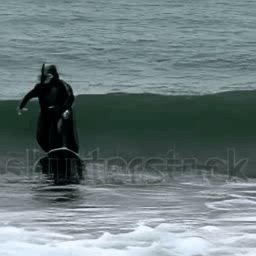🧪 This pipeline is for research purposes only.
ModelScope Text-to-Video Technical Report is by Jiuniu Wang, Hangjie Yuan, Dayou Chen, Yingya Zhang, Xiang Wang, Shiwei Zhang.
The abstract from the paper is:
This paper introduces ModelScopeT2V, a text-to-video synthesis model that evolves from a text-to-image synthesis model (i.e., Stable Diffusion). ModelScopeT2V incorporates spatio-temporal blocks to ensure consistent frame generation and smooth movement transitions. The model could adapt to varying frame numbers during training and inference, rendering it suitable for both image-text and video-text datasets. ModelScopeT2V brings together three components (i.e., VQGAN, a text encoder, and a denoising UNet), totally comprising 1.7 billion parameters, in which 0.5 billion parameters are dedicated to temporal capabilities. The model demonstrates superior performance over state-of-the-art methods across three evaluation metrics. The code and an online demo are available at https://modelscope.cn/models/damo/text-to-video-synthesis/summary.
You can find additional information about Text-to-Video on the project page, original codebase, and try it out in a demo. Official checkpoints can be found at damo-vilab and cerspense.
Let's start by generating a short video with the default length of 16 frames (2s at 8 fps):
import torch
from diffusers import DiffusionPipeline
from diffusers.utils import export_to_video
pipe = DiffusionPipeline.from_pretrained("damo-vilab/text-to-video-ms-1.7b", torch_dtype=torch.float16, variant="fp16")
pipe = pipe.to("cuda")
prompt = "Spiderman is surfing"
video_frames = pipe(prompt).frames[0]
video_path = export_to_video(video_frames)
video_pathDiffusers supports different optimization techniques to improve the latency and memory footprint of a pipeline. Since videos are often more memory-heavy than images, we can enable CPU offloading and VAE slicing to keep the memory footprint at bay.
Let's generate a video of 8 seconds (64 frames) on the same GPU using CPU offloading and VAE slicing:
import torch
from diffusers import DiffusionPipeline
from diffusers.utils import export_to_video
pipe = DiffusionPipeline.from_pretrained("damo-vilab/text-to-video-ms-1.7b", torch_dtype=torch.float16, variant="fp16")
pipe.enable_model_cpu_offload()
# memory optimization
pipe.enable_vae_slicing()
prompt = "Darth Vader surfing a wave"
video_frames = pipe(prompt, num_frames=64).frames[0]
video_path = export_to_video(video_frames)
video_pathIt just takes 7 GBs of GPU memory to generate the 64 video frames using PyTorch 2.0, "fp16" precision and the techniques mentioned above.
We can also use a different scheduler easily, using the same method we'd use for Stable Diffusion:
import torch
from diffusers import DiffusionPipeline, DPMSolverMultistepScheduler
from diffusers.utils import export_to_video
pipe = DiffusionPipeline.from_pretrained("damo-vilab/text-to-video-ms-1.7b", torch_dtype=torch.float16, variant="fp16")
pipe.scheduler = DPMSolverMultistepScheduler.from_config(pipe.scheduler.config)
pipe.enable_model_cpu_offload()
prompt = "Spiderman is surfing"
video_frames = pipe(prompt, num_inference_steps=25).frames[0]
video_path = export_to_video(video_frames)
video_pathHere are some sample outputs:
An astronaut riding a horse.

|
Darth vader surfing in waves.

|
Zeroscope are watermark-free model and have been trained on specific sizes such as 576x320 and 1024x576.
One should first generate a video using the lower resolution checkpoint cerspense/zeroscope_v2_576w with [TextToVideoSDPipeline],
which can then be upscaled using [VideoToVideoSDPipeline] and cerspense/zeroscope_v2_XL.
import torch
from diffusers import DiffusionPipeline, DPMSolverMultistepScheduler
from diffusers.utils import export_to_video
from PIL import Image
pipe = DiffusionPipeline.from_pretrained("cerspense/zeroscope_v2_576w", torch_dtype=torch.float16)
pipe.enable_model_cpu_offload()
# memory optimization
pipe.unet.enable_forward_chunking(chunk_size=1, dim=1)
pipe.enable_vae_slicing()
prompt = "Darth Vader surfing a wave"
video_frames = pipe(prompt, num_frames=24).frames[0]
video_path = export_to_video(video_frames)
video_pathNow the video can be upscaled:
pipe = DiffusionPipeline.from_pretrained("cerspense/zeroscope_v2_XL", torch_dtype=torch.float16)
pipe.scheduler = DPMSolverMultistepScheduler.from_config(pipe.scheduler.config)
pipe.enable_model_cpu_offload()
# memory optimization
pipe.unet.enable_forward_chunking(chunk_size=1, dim=1)
pipe.enable_vae_slicing()
video = [Image.fromarray(frame).resize((1024, 576)) for frame in video_frames]
video_frames = pipe(prompt, video=video, strength=0.6).frames[0]
video_path = export_to_video(video_frames)
video_pathHere are some sample outputs:
Darth vader surfing in waves.

|
Video generation is memory-intensive and one way to reduce your memory usage is to set enable_forward_chunking on the pipeline's UNet so you don't run the entire feedforward layer at once. Breaking it up into chunks in a loop is more efficient.
Check out the Text or image-to-video guide for more details about how certain parameters can affect video generation and how to optimize inference by reducing memory usage.
Make sure to check out the Schedulers guide to learn how to explore the tradeoff between scheduler speed and quality, and see the reuse components across pipelines section to learn how to efficiently load the same components into multiple pipelines.
[[autodoc]] TextToVideoSDPipeline - all - call
[[autodoc]] VideoToVideoSDPipeline - all - call
[[autodoc]] pipelines.text_to_video_synthesis.TextToVideoSDPipelineOutput